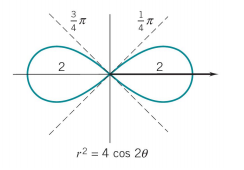How do you find the area of the region bounded by the polar curve #r^2=4cos(2theta)# ?
1 Answer
The first thing to remember that an integral is a way to add up an infinite number of areas. For rectangular coordinates (
literally means "let's find the area of an infinite numbers of rectangles between
Polar coordinates, though it seems more complicated, follows the same general pattern. The big difference is that we're not dealing with rectangles. We are dealing with sectors of a circle. Also known as pizza slices.

The area of a single pizza slice of a circle is
(remember this particular area formula only works if
So the area of an infinite number of "pizza slices" is
which literally means "let's find the area of an infinite number of pizza slices between
Now for your specific problem, we substitute
Now we have to determine a suitable
First we remember what a lemniscate looks like.

The
It looks like the simplest thing to do is to have our angle go from
So...

